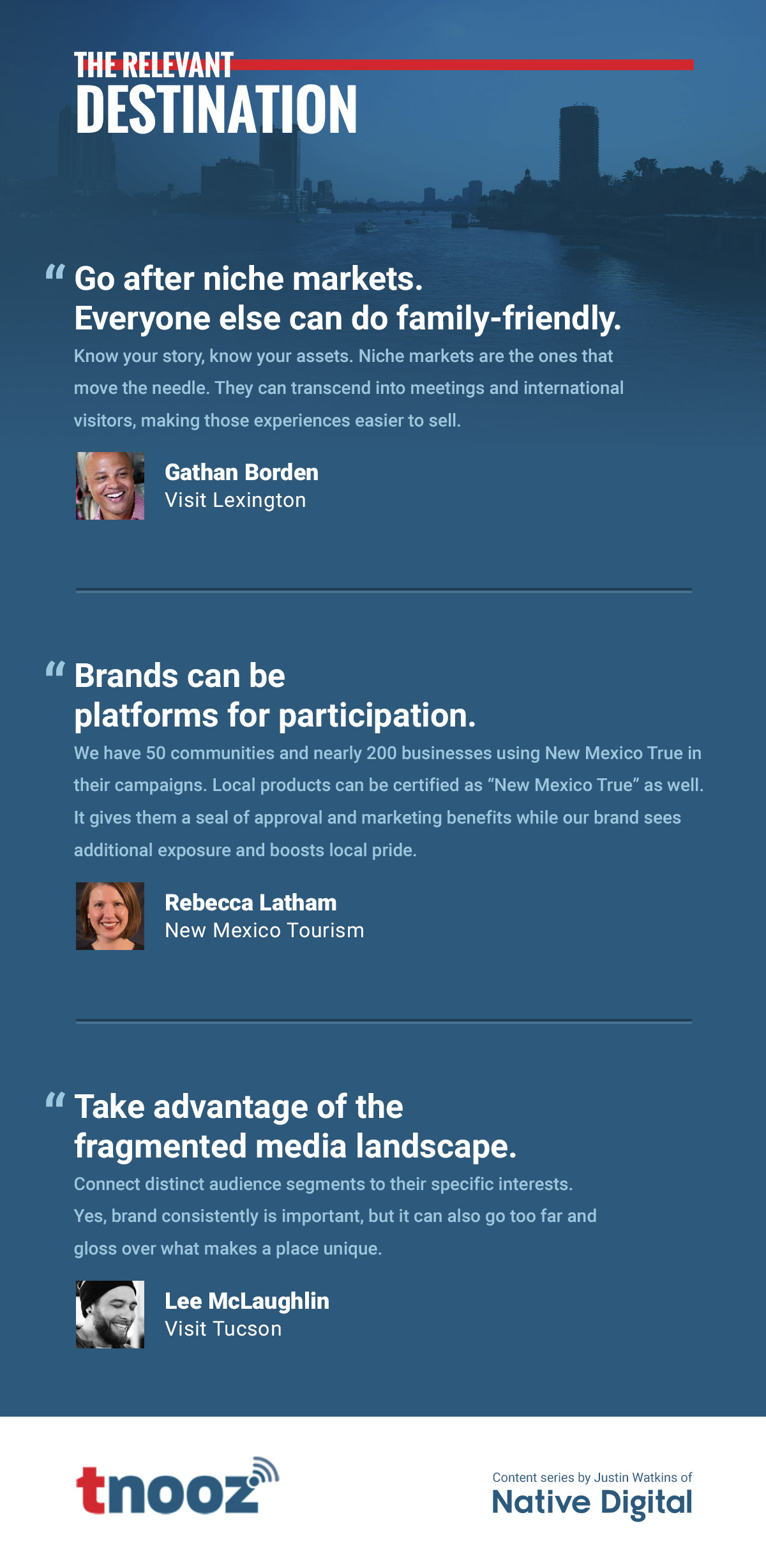
Is your destination relevant? Destination marketers weigh in on staying top-of-mind with travelers
By cameron in Uncategorized
This is a viewpoint interview series by Justin Watkins, Creative Strategist at Native Digital
There is an ongoing debate on how destinations stay relevant to travelers. It’s a discussion often had among destination marketing organizations and partners whose roles and tactics continue to evolve as the travel, marketing, and technology landscapes continue to disrupt tried-and-true methods of the past.
In the Relevant Destination Q&A series we hear a variety of perspectives and pro-tips on how destination can prove their value to stakeholders and their community as a whole. We will introduce the guests and then dive right into their answers to questions related to nurturing a relevant destination. There’s also a graphic at the end of this article that pulls out some of the most salient quotes.
This week’s guests:
- Gathan Borden, Vice President of Marketing at Visit Lexington
- Rebecca Latham, Cabinet Secretary at New Mexico Tourism Department
- Lee McLaughlin, Senior Director of Marketing at Visit Tucson

Our destination marketing panel.
Q1: Locals, drive, fly, international, meetings, leisure… where do you start when prioritizing your audience?
Gathan: “Go after niche markets. Everyone else can be family-friendly. Know your story, know your assets. Niche markets are the ones that move the needle. They can transcend into meetings and international visitors, making those experiences easier to sell.”
Lee: “With the massive amounts of data available it is now possible to connect with visitors based on their interests. The conversation used to revolve almost entirely around markets of origin, and while this is still an important factor, it is now possible for us to connect with the right visitor regardless of where they are located.”
Q2: What new offerings should destinations be developing? We’re seeing plenty of trails, passbooks, pages, events, etc – what makes the most sense?
Lee: “One of the areas that we are focused on is promoting greater connectivity and mobility throughout the region, specifically in our downtown area. We’ve created a bike-share program and are working to develop self-guided tours and way-finding resources that make it easier for visitors to get around and allow us to promote areas that might otherwise be difficult to find.”
Gathan: “The forward-thinking DMOs are the ones who are having conversations with existing events and festivals and trying to find ways to grow homegrown festivals into more of a regional or national draw. I believe that every DMO should have a Destination Development Plan, that outlines how they would like to see the city grow in terms of quality tourism product over the course of 5, 10 and even 15 years.”
Rebecca: “We launched the Rural Pathways Project to cultivate and create new experiences. We work with rural communities on their unique points of difference. So now you can learn to build a lowrider at a newly opened museum or trek across some of the darkest parts of the world on the Dark Skies Trail.”
Q3: What’s your latest perspective on the value destination branding can provide to your local community?
Lee: “Take advantage of the fragmented media landscape. Connect distinct audience segments to their specific interests. Yes, brand consistently is important, but it can also go too far and gloss over what makes a place unique.”
Rebecca: “Brands can be platforms for participation. We have 50 communities and nearly 200 businesses incorporating New Mexico True into their campaigns. Local products can be certified as “New Mexico True” as well. It gives them a seal of approval and marketing benefits while our brand sees additional exposure and boosts local pride.”
Gathan: “Work with the local community to peel back the layers of the destination and get into the heart of the city – which is the people. By showcasing the stories of the destination, as told by the local community, DMOs now can be seen as a viable agency that not only helps tourism, but also improves the quality of life in a city.”
Q4: What tactics have you had success with that other DMOs should consider?
Lee: “Partnering with recognized travel brands, platforms and publishers has become increasingly important for DMOs. These partnerships allow us to leverage data and amplify our message to travelers throughout every point in the decision making process. Previously, some of these groups may have been viewed as competition, but as their presence grows we have to look beyond “owned” channels to drive conversions and embrace these types of partnerships.”
Gathan: “It’s not too late for DMOs who aren’t utilizing UGC. The forward-thinking DMOs are using UGC in more ways than just populating social media channels; It can be repurposed for printed collateral, advertisements (in-market and out-of-market), gallery hops around town, and more.”
Rebecca: “Our New Mexico True Certified (NMTC) program is a mutually beneficial, non-endemic partnership for local businesses. NMTC leverages the tourism brand to bolster the state’s economy in manufacturing and agriculture. Small businesses are receiving the marketing benefit of working with our department, and we’re accomplishing one of our strategic initiatives to grow in-state pride and advocacy.”
Key takeaways
- Consider interest-based audiences not just geographic-based audiences. Especially as online platforms enables the ability to identify and speak directly with them.
- Have a roadmap for product development to collaborate to enhance the experience of travelers as well as locals
- Brands can be platforms for participation. Find new ways to incentive collaboration and share resources to extend your reach.
- DMO’s can be a primary storyteller and maybe more importantly a primary curator of visitor stories.
Opinions and views expressed by all guest contributors do not necessarily reflect those of tnooz, its writers, or its partners.
![]()


